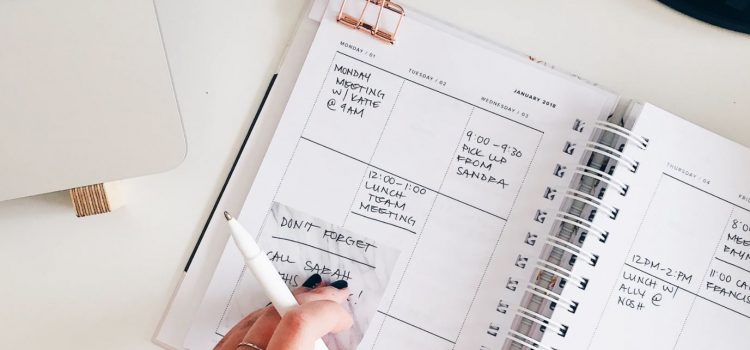

This article is an excerpt from the Shortform book guide to "The Only Study Guide You'll Ever Need" by Jade Bowler. Shortform has the world's best summaries and analyses of books you should be reading.
Like this article? Sign up for a free trial here.
Why is a schedule for school important? How do you make a study schedule?
Study schedules have proven to be beneficial for students struggling with time management. Jade Bowler’s scheduling method in The Only Study Guide You’ll Ever Need will help you identify your priorities and complete important tasks.
Read on to learn how to make a study schedule that fits your needs.
Make a Schedule
Bowler claims that learning how to make a study schedule will ensure you’re making the best use of your time, helping you accomplish your schoolwork while maintaining free time for extracurricular and non-academic activities. Her scheduling method will help you identify your priorities, allot blocks of time to complete important tasks, and determine which study techniques will optimize your learning.
(Shortform note: In Eat That Frog!, Brian Tracy reiterates the importance of scheduling, citing the 10/90 rule as evidence: spending 10% of your time on a task planning it (for instance, by prioritizing it, scheduling it, and determining how you’ll complete it) will reduce the time required to complete it by 90%.)
Bowler’s method for making a schedule can be broken into four steps.
Step #1: List Your Obligations
Bowler explains that the first step when creating your schedule is to write down every obligation you must complete each month (like projects, exams, and so on); their deadlines; and all the tasks that are required to complete them. You should amend this list whenever you receive a new obligation or deadline. For example, your November list might look like this:
November:
- Obligation: Science homework, November 2
- Task: complete 3 equations
- Obligation: Swim meet, November 5
- Task: leave the afternoon free, reschedule group study session
- Obligation: History exam, November 30
- Tasks: memorize each caliphate of the Islamic Empire and its time span, learn the five most impactful caliphs and their major beliefs and accomplishments
Step #2: Make Plans
Once you’ve listed your obligations, deadlines, and tasks, Bowler suggests analyzing which study methods would best help you accomplish each task. These will be the plans you need to enact to complete the task effectively.
For example, the plans (study techniques) for your history exam might include:
- Create flashcards—one hour
- Study flashcards—30 minutes per session
- Create a story to remember when each caliph lived, his accomplishments, and his beliefs—one hour
- Perform a memory test about each caliph—40 minutes per test
- Take a mock exam—one hour
Step #3: Prioritize Your Tasks and Plans
Next, Bowler recommends prioritizing your tasks and plans based on 1) your level of understanding of the topic and 2) each task or plan’s deadline. To do this, devise symbols that indicate each task’s priority level and write the correct symbol next to each task and plan. For example, you might write three exclamation points next to high-priority items, two next to medium-priority items, and one next to low-priority items.
How do you know which tasks to prioritize? Bowler notes that if your understanding of a task or plan’s topic is lacking, the task or plan is important to focus on and will require a larger time commitment than something you already understand well. Therefore, these tasks and plans will be of higher priority. However, you must also take into account your deadlines—tasks and plans with immediate deadlines, like homework that’s due the next day, will usually have higher priority than plans that can be completed later in the month.
However, tasks with impending deadlines might not always take the highest priority. For example, imagine that you have two upcoming obligations: two homework assignments due in five days, and a history exam next month on topics that you don’t yet understand fully. While the homework is due sooner, you’ll need a long time to fully master the exam content. To prioritize your plans for these obligations, determine what needs to get done first to both meet deadlines and improve your understanding in time to pass the exam. In this case, you should spend an hour creating flashcards for the exam first, because you need as much time as possible to memorize them before the exam; then, you should do the homework, because it’s the most immediate deadline after that.
Step #4: Schedule Your Tasks
Once you know the priority levels of your tasks, schedule a time to complete them. Bowler recommends scheduling tasks week by week for up to a month in advance. You should revisit your schedule at the beginning of each week to make a daily and hourly schedule. Bowler notes that you should consider spaced repetition when scheduling your study times. For example, “study flashcards” might be one task on your list, but scheduling and performing it only once won’t improve your understanding of the material. Instead, use the spaced repetition technique by scheduling multiple flashcard sessions at regular intervals.

———End of Preview———
Like what you just read? Read the rest of the world's best book summary and analysis of Jade Bowler's "The Only Study Guide You'll Ever Need" at Shortform.
Here's what you'll find in our full The Only Study Guide You'll Ever Need summary:
- Why school doesn't have to be chronically overwhelming
- How students can manage their mindset, study habits, and time
- Science-backed time management and study techniques to help you ace your exams






